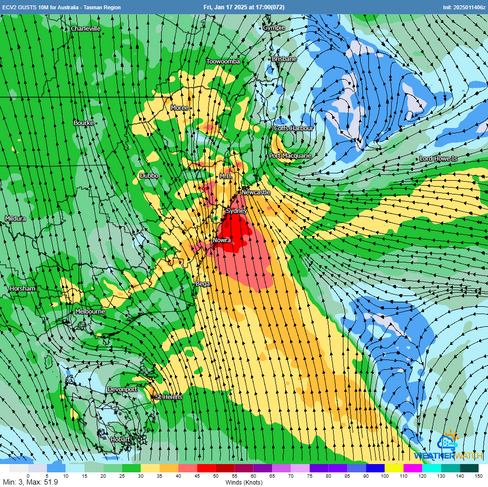NSW Gales & Heavy Rain to Follow East Australia Severe Storm Outbreak
- Weatherwatch
- Jan 15
- 4 min read
January 15, 2025
A long-wave upper trough is continuing to generate severe weather across eastern Australia. While this has been more isolated in recent days, the potential for severe weather is set to expand today. Yesterday, parts of Stanthorpe and surrounding areas in Queensland were hit hard by giant hail, with hailstones the size of cricket balls causing significant damage to roofs, windshields, and solar panels.
Advanced Warning with SmartHail™
Weatherwatch’s SmartHail system provided residents with over 20 minutes of warning before the storm struck—ahead of the Bureau of Meteorology, which issued warnings only after the storm had already impacted the town. SmartHail uses groundbreaking, intelligent 3D radar tracking technology to forecast where thunderstorms are expected to move - providing valuable time to mitigate for hail damage.

Weatherwatch's SmartHail system warned residents of the hailstorm more than 20 minutes prior to the storm's impact, and 40 minutes before the BoM issued their first warning. Source: HailTracker
Why are Severe Storm Events Often "Clustered" Together
Severe thunderstorms are often clustered together due to "long-wave" upper troughs. These are broad, slow-moving regions of cold air in the upper atmosphere that enhance instability. A long-wave upper trough is a slow-moving region of cold air in the upper atmosphere. Instability is created when warm air rises; as long as the rising air remains warmer than the surrounding air, it will continue to ascend—often resulting in towering thunderstorm clouds. When the air in the upper atmosphere is colder, it increases the likelihood that ascending air will stay warm, making it a key factor in generating instability, which in turn produces thunderstorms.

A broad region of cold air in the upper atmosphere has been present across eastern Australia which has contributed to the increase in storm activity over the region. Today a stronger but smaller region of cold air in the upper atmosphere will provide additional instability and dynamics to increase severe storm activity. Source: MetCentre
A long-wave upper trough was responsible for hailstorms over northern NSW and southern Queensland in October and November last year. This pattern shifted into Western and Central Australia in late November and December bringing extensive showers and storms here during this time. Since the start of 2025, this long-wave upper trough has returned to eastern Australia, driving the recent increase in shower and storm activity.
Today: Severe storms from eastern Victoria to northern Queensland
Today is likely to be the last major day of severe thunderstorm activity. A stronger, smaller (short-wave) upper trough will sweep into NSW and will combine with high humidity to to generate areas of strong instability and increasing wind shear—both key ingredients for severe thunderstorm activity.
Storms containing large hail and damaging winds are expected to develop across eastern Victoria, large parts of eastern NSW, and extend into southeastern and central eastern Queensland. In northern Queensland, severe storm threats may focus more on damaging winds and heavy rainfall.

Strong areas of instability will extend from northern Queensland down into eastern Victoria with many areas likely to experience severe thunderstorm activity. Source: MetCentre
While Queensland has drawn much of the attention due to its higher instability, wind shear is weaker here. When strong instability is paired with weaker wind shear, the atmosphere can become unbalanced, meaning strong winds in storms can cause outflows that weaken storms over time.

ACCESS sounding across southern inland Queensland showing strong instability, but wind shear is a little weak and unbalanced for such strong instability. Severe storms, while likely, may be shorter lived as a result. Source: MetCentre
Further south, although instability is slightly weaker, the stronger wind shear may provide a better balance, supporting longer-lived storms. Yesterday’s storm over Stanthorpe exemplifies this balance—while neither instability nor wind shear were particularly strong, they were well-balanced enough to produce a long-lived, isolated supercell.

ACCESS sounding across the ACT shows slightly stronger wind shear which has the potential to support longer lived and better organised thunderstorms which may increase severe threats. Source: MetCentre
While storms are relatively likely to reach the coastline (particularly in NSW), the main focus of severe activity will likely remain on and west of the ranges, closer to the surface trough and initiation zones.
Tomorrow: NSW Low to Drive Heavy Rain & Gales
As the short-wave upper trough interacts with the NSW coastline, it is expected to induce a low-pressure system offshore. This will shift the focus to:
Damaging Winds: Gale-force winds along the NSW coastline during tomorrow and Friday
Heavy Rainfall: Concentrated in coastal and adjacent ranges of central to northern NSW, with localized flooding possible.
A low off the NSW coastline will bring gales and localised damaging wind gusts to coastal areas during tomorrow and Friday. Source: MetCentre
ACCESS and EC rainfall during the next 5 days indicating heavy rainfall. Source: MetCentre
Decrease in Storm Activity Ahead
While the long-wave upper trough will remain over eastern Australia into next week, a drier, more stable airmass is expected to push in from the southeast. This will help reduce storm activity despite the lingering cold air in the upper atmosphere. This does not mean no storms - only the spread of storm activity will decrease and become more isolated as severe storms could still be a possibility across parts of eastern Queensland and northeastern NSW tomorrow, depending on how rapidly the atmosphere dries out

ACCESS CAPE tomorrow shows very coastal instability. These days can be very isolated, but still generate severe thunderstorm activity. Source: MetCentre
Safety Tips for Severe Weather
With severe storms and coastal hazards anticipated, it’s vital to stay safe:
Avoid parking under trees or leaving vehicles exposed during hailstorms.
Seek shelter indoors at the first sound of thunder to avoid lightning risks.
Never drive through floodwaters—if it’s flooded, forget it!
Businesses should consider professional alerting or meteorological services for timely warnings.
Storm chaser Daniel Shaw lost their windscreen from the giant hail near Stanthorpe.
Weatherwatch – your trusted partner in weather intelligence.











